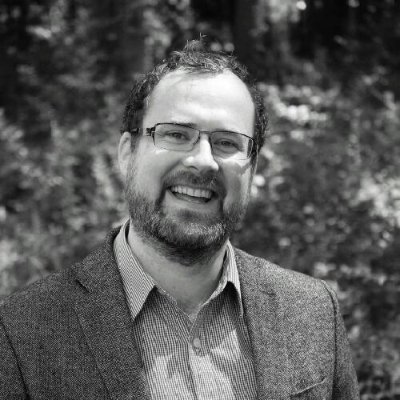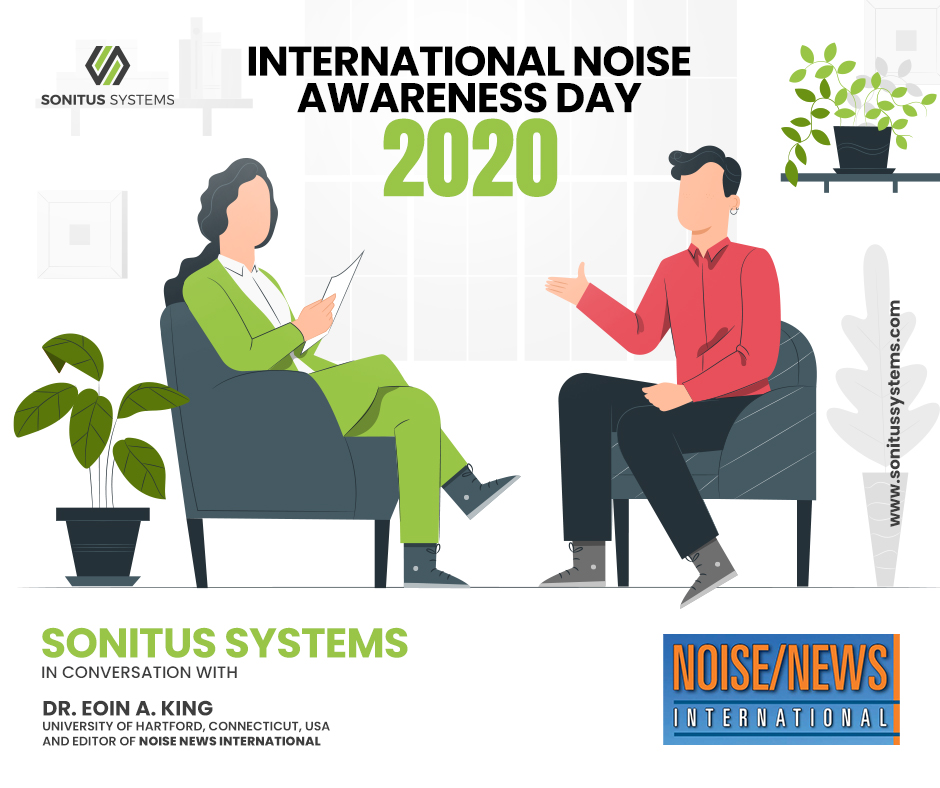We catch up with Kildare native, Eoin Anthony King, remotely as Covid-19 restrictions remain in place for Ireland, the US and for many countries across the world.
Editor of http://noisenewsinternational.net/, Associate Professor at the University of Hartford, Connecticut, US and Member of the European Union’s Noise Expert Group.
We catch up with Kildare native, Eoin Anthony King, remotely as Covid-19 restrictions remain in place for Ireland, the US and for many countries across the world.
Combined Music & Acoustics Programme
Eoin is an Associate Professor at the University of Hartford. He moved to the US in 2013 to work with the university’s unique acoustics programme; there are only a few similar programmes in the world and this is the only one in the US. This combined music and acoustics programme started in the 1970s. Students are required to audition to join the university’s music conservatory. As musicians, they take music classes, however, they are also training in acoustical engineering and take classes in acoustical engineering.
From the students’ perspective, many enter the programme with their primary focus on music – they are musicians first – and this allows them to follow their passion. Throughout the programme they work towards a full engineering degree, which provides excellent future career prospects. The programme often has a 100 percent job placement rate for graduates, with many securing permanent positions prior to graduation. While some pursue music, approximately half of the graduates work with acoustic consultancies, primarily in the areas of building and environmental noise.
Route to Acoustics
Eoin studied Mechanical Engineering in Trinity College Dublin, followed by a PhD in 2007 at the same university – acoustics with a focus on environmental noise. He is also a musician and plays guitar (Indie rock and roll).
In Ireland, he worked with the National Roads Authority (NRA Ireland, from 2007 to 2012) developing the organisation’s noise maps under the Strategic Noise Mapping Directive, the purpose of which was to define a common approach intended to avoid, prevent or reduce on a prioritised basis the harmful effects, including annoyance, due to exposure to environmental noise.
Evolution of the Industry
“The big change is computational power and resources. When I was doing my PhD, it took 24 hours to map 1sq.km of a city, whereas today, that same work might take one hour. These computational resources, coupled with the long-term, online noise monitoring has been game-changing for the industry. You can essentially listen to the sounds of a city in real time, which was unthinkable when the Environmental Noise Directive was first dreamed up.”
Before 2002, there was no specific or enforceable legislation in Ireland relating to environmental noise, including road traffic noise or aircraft noise. The Environmental Noise Directive provided the necessary guidance for individual sectors to follow. The NRA is now a great example of a sector leader in this space. Once the legislation was in place, principles of best practice began to emerge. While the Environmental Noise Directive does not call for monitoring, noise monitoring is a powerful addition to the Directive. Eoin considers that there is still a wide gap between minimum legislative compliance and industry best practice – the scale of this discrepancy varies from country to country.
In 2020, best practice emanates from academic research and literature. What constitutes best practice is well-established, however, there is a disconnect between what is documented in academic literature and what happens in industry. This disconnect is twofold; firstly, the people in charge of policy do not always have the necessary expertise to understand what is best practice so, according to Eoin, there needs to be a more robust link between subject experts and policymakers. He points out that some countries do this better than others (“Ireland is a little bit lacking”). Secondly, there needs to be more active engagement with industry to help stakeholders understand and appreciate the benefits of best practice over minimum legislative compliance.
“The culture still needs to change, but I am not despairing of it as I know that there are companies that are pushing best practice and this is leading to greater innovation. This innovation is being driven by a simple desire to improve and apply best practice, rather than by policy. It would probably be more efficient if the policies were in place to drive this innovation, but we are not there yet.”
Significance of International Noise Awareness Day
“In Europe, noise is taken more seriously than in the rest of the world.”
There has been a growing citizen-awareness of environmental noise, and the impacts of this, in recent decades. This is true across the world, however, according to Eoin, Europe is leading the field having already implemented the Environmental Noise Directive 2002 and there is much research in the area of soundscapes emanating from this region.
Eoin is also a member of the EU’s Noise Expert Group, which works closely with the World Health Organisation (WHO) and the European Environmental Health Agency in relation to the adverse impact of noise on public health.
“As scientists and engineers, we know much more about the adverse effects caused by noise. There are studies and rigorous scientific underpinnings behind this, so we know much more about the problem, and citizens are becoming more informed, which is a good thing.”
Changing Trends and Innovation
Soundscapes
“One area of research that excites me is Soundscapes. The thing about a soundscape is instead of focusing on noise as a bad thing, soundscapes tend to focus on the overall acoustic environment being a good thing. A soundscape is about protecting what’s good, as opposed to punishing what’s bad. This is flipping the script in a positive way. Too often, when we think about noise, we think of it as a waste product that needs to be controlled, whereas when we think about soundscapes, we think about the acoustic environment as a resource that should be protected or improved. This trend is more likely to engage the public, because people are more inclined to talk about the good things rather than bad.”
‘Soundscape’ refers to a sound or combination of sounds that forms the acoustic environment locally; it encompasses both natural sounds and environmental sounds created by humans.
Hush City App
An excellent example of innovation in this area is this Hush City app, developed by Dr Antonella Radicchi, based on her research projects and activities in Berlin since 2016. This free mobile app maps quiet spaces in a city based on crowdsourced data. It is a great example of citizen science. Local residents and visitors can submit audio recordings and rate quiet areas in their cities. The aim of Hush City is to design an “open access, web-based map of quiet areas, with the potential of orientating plans and policies for healthier living.”
More details on Hush City here
Tranquility Rating Prediction Tool (TRAPT)
Eoin recently developed a tranquility map for Central Park in New York City – the Tranquility Rating Prediction Tool (TRAPT). Instead of mapping the areas inside Central Park that were bad, he mapped the areas that were good and tranquil. TRAPT judges the overall noise level together with visual features in the space. This has also been used in the development of tranquility trails in the UK. These tranquility trails allow space for citizens to reflect, while encouraging healthy exercise.
SONYC: Sounds of New York City
Sounds of New York City (SONYC) is a project developed at New York University. The project team is developing an IoT smart cities sensor/monitoring network with machine listening capabilities to identify individual sources of noise and how these component sounds change over time. This will distinguish road traffic noise, from construction noise or noise arising from people. Eoin describes this application of machine learning, or ML, to machine listening as significant and potentially transformative for the industry. Instead of simply measuring noise as a level in figures, it should be possible to isolate the sources of individual sounds, which will transform how these are addressed for the benefit of citizens.
“It’s almost like you have a person listening constantly with calibrated ears.”
About Dr. Eoin A. King
Dr. Eoin King is an Associate Professor of Mechanical Engineering at the University of Hartford, CT, USA. He sits on the Board of the Institute of Noise Control Engineering (USA) and is a member of both the European Commission Noise Expert Group and the International WELL Building Institute’s Sound Concept Advisory Panel. He is author/co-author of more than 70 academic journal papers, book chapters, conference papers and reports, including one book and is managing editor of Noise/News International, a quarterly publication of the International Institute of Noise Control Engineering. He holds a B.A. B.A.I. Mechanical Engineering (2003), Postgraduate Diploma in Statistics (2007) and PhD (2008) in Environmental Acoustics all from Trinity College Dublin, Ireland. Following EU postdoctoral research on noise assessment and control, he established a start-up noise and vibration consulting company before moving to the only US university that offers specialist undergraduate programs in acoustics and music. Outside of academia he has coached women’s rugby, organized a TEDX event, hobbled to the end of the NYC marathon, and was interviewed on Fox News to explain the Gaelic game of Hurling to a US audience.

About Sonitus Systems
The team at Sonitus Systems supply robust and reliable sound level monitoring equipment globally from their base in Dublin. Their award-winning products and services allow users to easily monitor and assess noise levels in any scenario to ensure local compliance. For more information, call the team at Sonitus Systems on +353 1 6778443 or email info@sonitussystems.com
